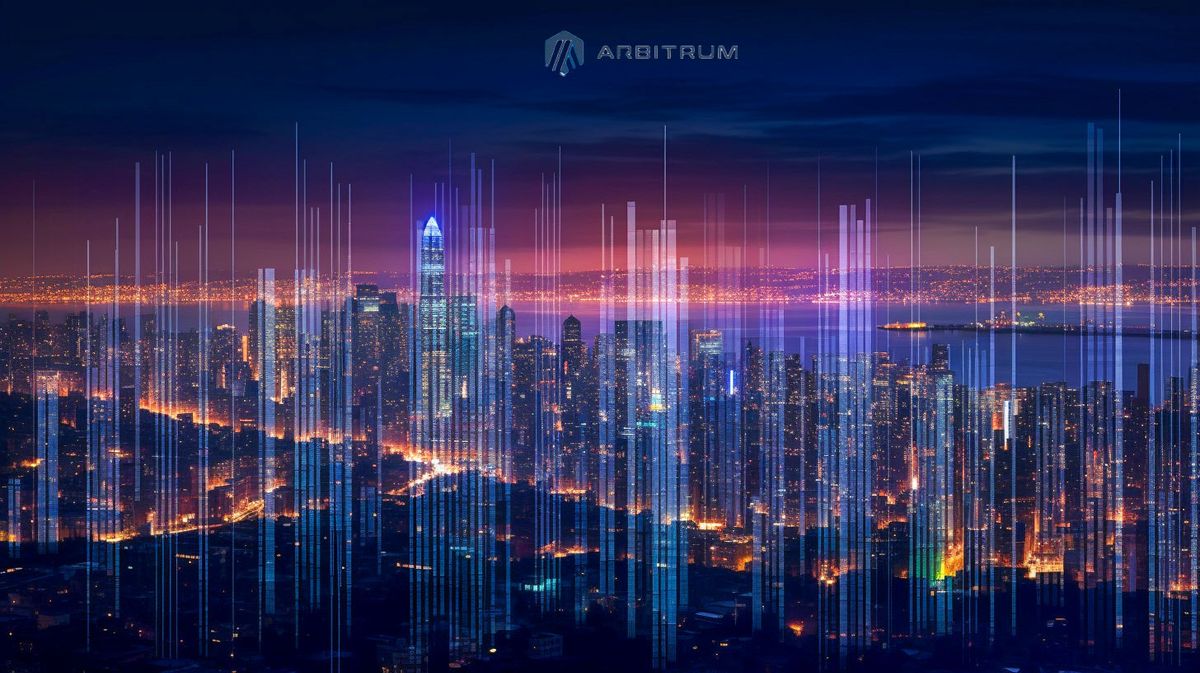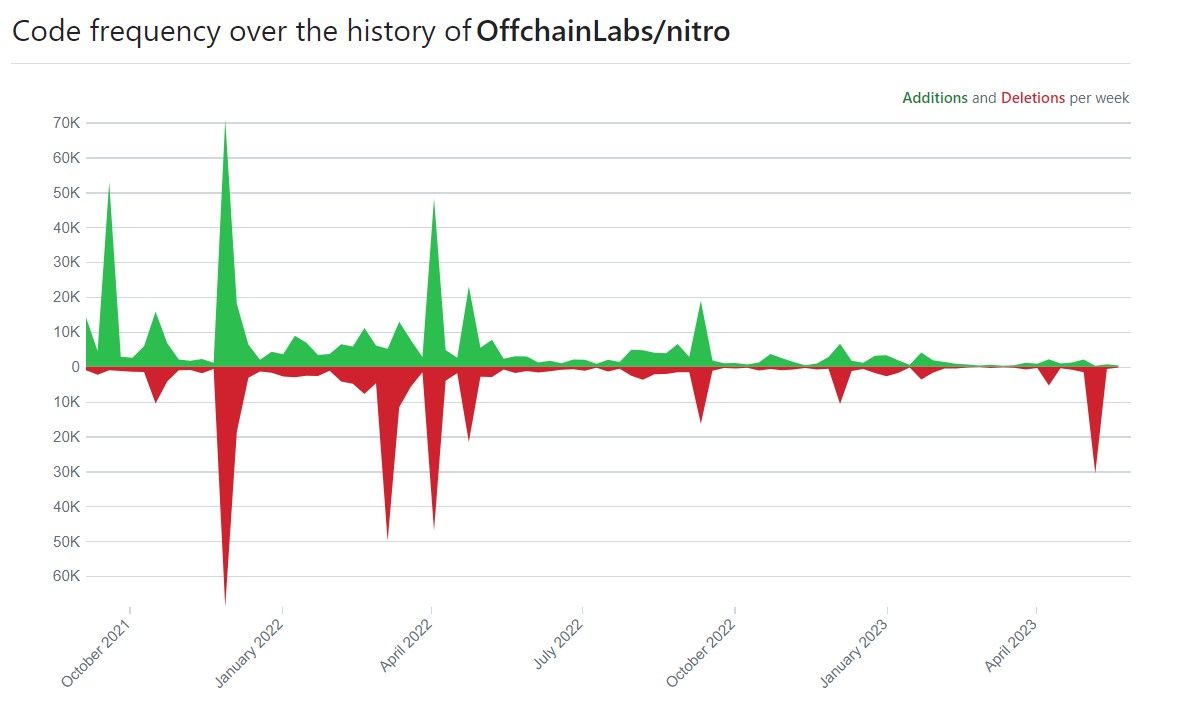Arbitrum Explained: Comprehensive Beginner's Guide to Ethereum's Layer 2 Solution

Ethereum, while being a leading blockchain platform, is currently grappling with a critical issue - escalating transaction costs. These high fees hamper the widespread adoption of Ethereum, limiting its true potential. An innovative technique called 'Optimistic Rollup' has emerged as a potential solution to this problem, offering to alleviate network congestion and reduce transaction costs. This article delves into one such promising Layer 2 (L2) solution - Arbitrum. Arbitrum is emerging as a key player in the blockchain space, providing seamless scalability and reduced fees.
What is Arbitrum?
Arbitrum is a layer-2 scaling solution for the Ethereum blockchain. It is designed to improve the speed and cost of transactions on Ethereum, while maintaining the security and decentralization of the Ethereum network.
At its core, Arbitrum is an Optimistic Rollup protocol - but what does this mean? Think of it as a sub-module within Ethereum that doesn't require Ethereum nodes to process every transaction. Optimistic rollups are a type of Layer 2 scaling solution that batch transactions off-chain and then submits them to the Ethereum blockchain for finality. This allows for faster and cheaper transactions while maintaining the Ethereum network's security. This fundamentally unique feature allows Arbitrum to scale Ethereum while inheriting its security.
But what ensures that fraud will be caught on this new platform? This is where the concept of "rollup" comes into play. Users' transaction data is directly posted on Ethereum, ensuring visibility into Arbitrum's operations and the ability to detect and prove fraud. Validators, those who move the Arbitrum chain state forward on Ethereum, play a crucial role in maintaining security. If there is even one honest validator, the chain remains secure.
Arbitrum not only alleviates the burden on Ethereum but also offers a seamless user experience similar to Ethereum's. This high level of Ethereum compatibility has been achieved through extensive development and an innovative approach called Nitro. This approach uses a modified version of Geth, the most widely used Ethereum implementation, transforming it into a trustless layer 2.
How does Arbitrum work?
Arbitrum uses optimistic rollups to achieve its goals. Basically, Optimistic Rollups are a Layer 2 scaling solution for Ethereum, which operate by running computations off-chain and posting the results to the Ethereum mainnet. In an optimistic rollup, transactions are aggregated into a single batch and processed off-chain within a smart contract. A data snapshot, or 'state root', is then submitted to the main Ethereum chain.
Here's where the "optimistic" part comes in: this solution assumes that these off-chain computations are correct, but any participant can challenge a fraudulent or incorrect computation. If a submitted state is challenged, a dispute resolution process known as "fraud-proof" begins, which analyzes the transactions in question and rolls back any illegitimate transactions. This methodology allows for significant scalability improvements while maintaining the security of the underlying Ethereum blockchain.
Now let's look at how Arbitrum implements this ...
Understanding the Arbitrum Transaction Process
Arbitrum, a second layer (L2) scaling solution for Ethereum, operates on a detailed transaction lifecycle to ensure security and integrity while offering efficient scalability. The process is executed through the Arbitrum Rollup protocol, and a sequence of carefully outlined stages begins with a transaction's creation by a client to its final confirmation back on the base layer (L1) blockchain. The lifecycle also integrates various finality checks to guarantee the transaction's finality at different stages.
1. Sequencer Receives Transaction
- The process starts with the Sequencer, responsible for ordering transactions, and receiving a transaction from a client either directly/offchain or from L1 via the Delayed Inbox.
2. Sequencer Orders Transaction (off-chain)
- Once the Sequencer receives a transaction, it orders it, executes it locally using the Arbitrum Nitro VM, and immediately provides a transaction receipt to the client.
3. Sequencer Posts Transaction in a Batch (on-chain)
- The Sequencer later posts a batch of L2 transactions, including the client's transaction, onto L1. If the Sequencer fails to include a transaction, the client can force include it after a delay period.
4. Validator Asserts RBlock that Includes Transaction
- An active, staked validator then runs the Arbitrum VM over the inputs in the Inbox, and makes an on-chain assertion about the chain's latest state, which is referred to as a rollup block or RBlock. If the transaction triggers any L2 to L1 messages, an RBlock will include an update to reflect its inclusion.
5. RBlock is Confirmed on L1
- After any potential disputes are resolved and sufficient time has passed, the RBlock is confirmed on L1, updating the Outbox root on L1. If the client's transaction includes any L2-to-L1 messages, only after this confirmation can the message be executed in the Outbox on L1.
Finality Checks
Throughout the process, there are three primary stages of finality checks:
Trusted/Soft Confirmation: At this stage, finality depends on trusting the Sequencer. However, even a malicious Sequencer can, at most reorder or temporarily delay transactions but cannot forge a transaction or propose an invalid state update.
Ethereum-Equivalent Finality: After the Sequencer posts a batch, the transaction's ordering is determined by L1, and its state can be computed. Therefore, a client can consider their transaction as finalized on L1.
L2-to-L1 Messages Executable on L1: After the RBlock is confirmed on L1, if the client's transaction included an L2-to-L1 message, it can now be executed on L1, guaranteeing finality of the L2-to-L1 message.
Why Arbitrum Stands Out
- Fraud-proof mechanism: Arbitrum uses a fraud-proof mechanism to ensure the security of the system. This means that if someone tries to cheat the system, they will be penalized.
- Full compatibility with EVM: Arbitrum is fully compatible with the Ethereum Virtual Machine (EVM). This means that any DApp that is built on Ethereum can be ported to Arbitrum without any changes.
- High scalability & Low transaction fees: Arbitrum is designed to be highly scalable. It can process up to 40,000 transactions per second.
| Property | Value |
|---|---|
| Token Symbol | ARB |
| Circulating Supply | 1,275,000,000 ARB (12.75%) |
| Total Supply | 10,000,000,000 ARB |
| Transaction Speed (Potential) | 40,000 TPS |
| Transaction Speed (Current) | 5.8 TPS |
| Average Gas Fee | 0.10 Gwei |
| Average Block Time | 15 seconds |
Comparison between Optimistic & zk Rollup
| Optimistic Rollups | zk-Rollups | |
|---|---|---|
| Data Availability | On-chain | On-chain |
| Computation | Off-chain | Off-chain |
| Consensus | Fraud proofs | Validity proofs |
| Withdrawal Speed | 1 week (faster with bridging protocols) | Almost instant |
| Compatibility with Ethereum Smart Contracts | High (supports EVM) | Low-Medium (need to use zk-SNARK friendly programming language) |
| Transaction Cost | Lower than Layer 1 Ethereum | Lower than Layer 1 Ethereum, but higher than Optimistic Rollups due to complex computations |
| Security | Relies on fraud proofs, with a one week dispute period | Relies on validity proofs, offers near-instant finality |
You might also like the below article for an in-depth look

Arbitrum vs. Optimism: Exploring the Frontiers of Layer 2 Ethereum Scaling
Arbitrum and Optimism are two of the most popular Layer 2 scaling solutions for Ethereum. Both solutions use optimistic rollups to achieve scalability, security, and compatibility with Ethereum. However, there are some key differences between the two platforms.
| Arbitrum | Optimism | |
|---|---|---|
| Fraud Proofs | Uses multi-round fraud proofs, which are more efficient than single-round fraud proofs used by Optimism. | Uses single-round fraud proofs, which are faster than multi-round fraud proofs used by Arbitrum. |
| EVM Compatibility | Supports all EVM programming languages | limited to Solidity. |
| Gas Fees | Currently more expensive than Optimism. | Currently cheaper than Arbitrum. |
| Complexity | Less complex than Optimism | More complex than Arbitrum |
| Adoption | More widely adopted than Optimism | Less widely adopted than Arbitrum |
Developer Activity
On August 31, 2021, Offchain Labs announced the official launch of Arbitrum One mainnet. So far, we see 8,173 commits on GitHub , which is commendable.

As expected, the Developers activity was strong during Mainnet launch and then constant thereafter.

Arbitrum Nova and Arbitrum One
They are both layer-2 scaling solutions for the Ethereum blockchain. However, there are some key differences between the two.
Arbitrum Nova is an AnyTrust chain that aims for ultra-low transaction fees. Nova differs from Arbitrum One by not posting transaction data on chain, but to Data Availability Committee. In doing so, Nova achieves significant cost savings by first sending the data to the committee and only falls back to putting data on-chain if the committee fails to do its job.
Arbitrum One is a Optimistic rollup chain that is designed to be more secure and decentralized than Nova. One posts all transaction data on chain, which means that it is more resistant to censorship and attack. However, this also means that One is more expensive than Nova.
Here is a table comparing the key differences between Arbitrum Nova and Arbitrum One:
| Feature | Arbitrum Nova | Arbitrum One |
|---|---|---|
| Security | Less secure and decentralized than Arbitrum One | More secure and decentralized than Arbitrum Nova |
| Speed | Faster than Arbitrum One | Slower than Arbitrum Nova |
| Cost | Cheaper than Arbitrum One | More expensive than Arbitrum Nova |
| Adoption | Less widely adopted than Arbitrum One | More widely adopted than Arbitrum Nova |
Overall, Arbitrum Nova is a good choice for projects that need to scale quickly and cheaply. Arbitrum One is a good choice for projects that need to scale even faster and cheaper and are willing to trade off some speed for security.
The Future of Arbitrum
As of mid-2023, the future of Arbitrum looks promising. The Layer 2 scaling solution continues to foster a vibrant ecosystem of decentralized applications (dApps), each benefiting from the advantages of improved scalability and reduced gas costs.
The community anticipates a rise in adoption, which will be facilitated by ongoing improvements in user experience and increased awareness of Layer 2 solutions. As the Ethereum network continues to face scalability challenges, Arbitrum's proposition becomes ever more vital.
Disclaimer
*The information and analysis provided in this article are intended for educational and informational purposes only and should not be considered as financial, investment, or professional advice. While our team strives to ensure the accuracy and reliability of the content, we make no representations or warranties of any kind, express or implied, about the completeness, accuracy, reliability, suitability, or availability of the information presented.
The content within this article may include opinions and forward-looking statements that involve risks and uncertainties. The blockchain and cryptocurrency markets are highly volatile, and past performance is not indicative of future results. Any reliance you place on the information presented is strictly at your own risk. Before making any investment decisions, we highly recommend consulting with a qualified financial advisor or conducting your own thorough research.
By accessing and using the information provided in this article, you acknowledge and agree that neither the authors, publishers, nor any other party involved in the creation or delivery of the content shall be held liable for any direct, indirect, incidental, consequential, or punitive damages, including but not limited to loss of profits, goodwill, or data, arising out of your use or inability to use the information provided or any actions you take based on the information contained within this section.*

